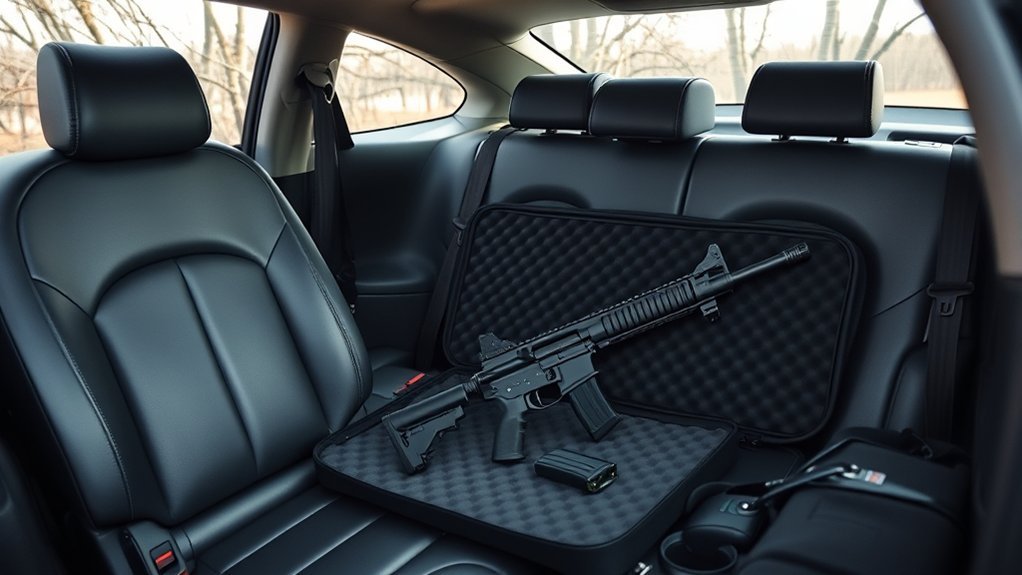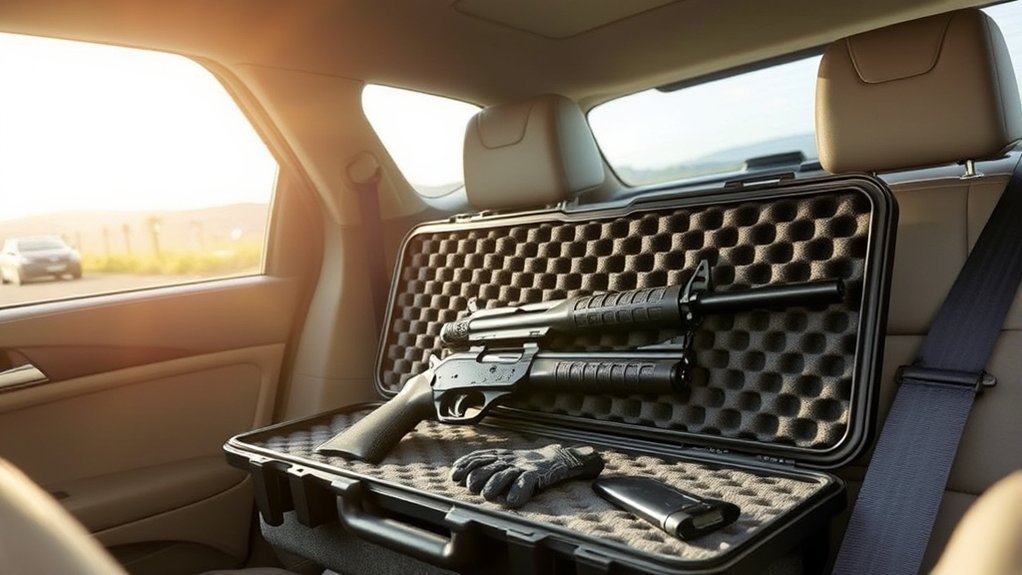It’s interesting how many people assume transporting firearms in a car is straightforward, yet the reality is often more complicated. You must navigate a maze of state and federal regulations that dictate how and where you can carry firearms. Understanding the nuances of these laws is essential. Failing to comply can lead to serious legal consequences, which raises the question: do you know the specific requirements for your state?
Understanding State Laws on Firearm Transportation

When you’re transporting firearms in a car, it’s essential to understand the varying state laws that govern this practice. Each state has specific regulations regarding how firearms must be stored and transported, often differentiating between loaded and unloaded weapons. Some states require firearms to be stored in a locked container, while others may mandate that firearms be out of reach of the driver and passengers. Additionally, certain states have restrictions on the types of firearms that can be transported. It’s vital to research the laws in the states you’ll be traveling through, as violations can result in severe penalties. Always keep updated with the latest regulations, since they can change frequently and may differ greatly from one state to another.
Federal Regulations Governing Firearm Transport

When transporting firearms, it’s essential to understand the federal regulations that govern this process. These guidelines outline how firearms should be stored and secured, especially during interstate travel. Familiarizing yourself with these rules can help guarantee compliance and avoid potential legal issues.
Firearm Transportation Guidelines
Understanding the federal regulations governing firearm transport is vital for responsible gun owners, as non-compliance can lead to serious legal consequences. When transporting firearms, make certain they are unloaded and stored in a locked container, separate from ammunition. It’s important to keep firearms out of reach from passengers, especially minors. Use a hard-sided case for added security, and consider using cable locks for additional safety. Always be aware of your vehicle’s location; firearms should not be visible to passersby. Familiarize yourself with specific regulations regarding concealed carry permits, as these can vary. Finally, maintain documentation of ownership and any permits to validate your right to possess the firearm during transport.
Interstate Transport Regulations
Transporting firearms across state lines involves specific federal regulations that gun owners must be aware of to guarantee compliance. The Firearm Owners Protection Act (FOPA) allows you to transport firearms for lawful purposes, provided they’re unloaded and stored in a separate compartment from ammunition. When crossing state lines, it’s essential to understand that state laws may differ considerably, so always research the regulations of your destination state. Additionally, firearms must be legal to possess in both the originating and destination states. Keep documentation handy, such as receipts or permits, to clarify ownership if questioned. Failure to adhere to these regulations can lead to severe penalties, including fines or imprisonment. Stay informed to guarantee safe and legal transport.
Safe Storage Practices While Traveling

Although you may feel confident in your ability to handle firearms, safe storage practices while traveling are essential for guaranteeing both your safety and that of others. First, always store firearms in a locked container, such as a gun safe or a locked trunk, to prevent unauthorized access. Make sure that ammunition is stored separately from the firearm. It’s also wise to keep firearms out of sight, minimizing the risk of theft. Use cable locks or trigger locks as an additional safety measure. When traveling, familiarize yourself with local laws regarding firearm storage, as regulations can vary considerably. Finally, regularly inspect your storage methods to make certain they remain secure and effective throughout your journey. Prioritizing these practices contributes to a safer travel experience.
Carrying vs. Transporting: Key Differences
When it comes to firearms, distinguishing between carrying and transporting is essential for compliance with laws and safety practices. Carrying typically refers to having a firearm on your person, either openly or concealed, while transporting involves placing the firearm in a vehicle without immediate access. The legal implications of each can vary considerably. When you’re carrying, you must adhere to specific regulations regarding permits and visibility, depending on your state’s laws. In contrast, transporting often requires the firearm to be unloaded and stored in a secured case or compartment. Understanding these distinctions helps guarantee that you comply with legal requirements and prioritize safety during your travels. Always check local laws to confirm your responsibilities in each scenario.
Traveling Across State Lines: What to Know
If you plan to travel across state lines with a firearm, understanding the varying laws governing transportation is vital. Each state has its own regulations regarding firearms, which can affect how you legally transport your weapon. Some states allow firearms to be carried openly, while others require them to be concealed or stored in a locked container. It’s important to know if your destination state recognizes your home state’s permit and what restrictions might apply. Additionally, federal laws, like the Firearm Owners Protection Act, might offer some protections during interstate travel. Always make certain your firearm is unloaded and stored properly while in transit to comply with both state and federal laws, preventing any legal issues during your journey.
Special Considerations for Different Types of Firearms
Understanding the laws for transporting firearms across state lines is just the beginning; different types of firearms come with their own unique considerations. Handguns, shotguns, and rifles often have varying regulations regarding storage, transport methods, and permissible ammunition.
| Firearm Type | Transport Method | Considerations |
|---|---|---|
| Handgun | Secured in a case | Some states require locks |
| Shotgun | Unloaded, cased | Must be separate from ammo |
| Rifle | Unloaded, in trunk | Some states mandate specific transport routes |
Familiarizing yourself with these specifics is essential to guarantee compliance and avoid any legal issues while traveling. Always check local laws as they can differ markedly from one jurisdiction to another.
Penalties for Non-Compliance and Legal Consequences
Failing to comply with firearm transport regulations can result in severe legal consequences, often including hefty fines or even criminal charges. Each state has specific laws regarding how firearms must be transported, and ignorance of these laws isn’t typically accepted as an excuse. If you’re caught violating these regulations, you could face misdemeanor or felony charges, depending on the severity of the violation and the jurisdiction. Additionally, law enforcement may seize your firearm, and your right to carry could be jeopardized. Penalties can escalate for repeat offenders, leading to more significant fines or longer prison sentences. It is crucial to stay informed about the laws in your area to avoid these potentially life-altering consequences.
Conclusion
When transporting firearms, it’s essential to understand the laws that apply to you. Did you know that nearly 1 in 5 gun owners are unaware of their state’s transportation regulations? This lack of knowledge can lead to serious legal troubles, including hefty fines or even criminal charges. By staying informed and practicing safe storage, you can protect yourself and others while ensuring compliance with the law. Always prioritize safety and awareness on the road.

